Evaluation of ecological risk due to suspended particulate matter-bound heavy metals deposited on selected plants in an urban area
IF 6
2区 工程技术
Q1 ENVIRONMENTAL SCIENCES
引用次数: 0
Abstract
Heavy metal concentrations bound to suspended particulate matter (SPM) originating from industrial processes, vehicular emissions, road dust, and solid waste incineration pose serious ecological risks. Their persistent deposition on vegetation disrupts the ecological balance and endangers environmental health through long-term accumulation in sensitive ecosystems. This study investigated the ecological risks posed by SPM-bound heavy metals (Ag, Cd, Bi, Pb, Ga, Co, Mn, Cu, Mo, Ni, V, Zn, and Cr) deposited on the leaves of selected plant species across Delhi, India, during pre- and post-monsoon. The assessment involved calculating the enrichment factor (EF), contamination factor (Cf), contamination degree (Cdeg), potential ecological risk factor (Er), and potential ecological risk index (PER). Two-way ANOVA, Pearson's correlation, and Hierarchical Cluster Analysis (HCA) were employed for statistical analyses. The highest EF values were recorded for Co (11.23), Pb (3.26), and Ni (7.17) at the traffic-prone site in Bougainvillea glabra. Maximum Cf values were observed for Cd (3.58) and Zn (11.17). The highest Er values were noted for Cd (158.34; Ficus religiosa L), Ni (5.89; F. religiosa), Pb (23.25; Ficus benjamina L), Cu (10.89; F. benjamina), and Zn (13.78; B. glabra). F. religiosa exhibited the highest PER of 199.39, while B. glabra showed the lowest of 110.17. Two-way ANOVA revealed significant differences (p < 0.05) in SPM-bound heavy metal concentrations. Cr exhibited positive correlations (0.358 ≤ r ≤ 0.817) with Ni, Pb, and Cu. Findings highlighted critical ecological risk from SPM-bound heavy metals in urban areas, necessitating suitable mitigation efforts.

求助全文
约1分钟内获得全文
求助全文
来源期刊

Urban Climate
Social Sciences-Urban Studies
CiteScore
9.70
自引率
9.40%
发文量
286
期刊介绍:
Urban Climate serves the scientific and decision making communities with the publication of research on theory, science and applications relevant to understanding urban climatic conditions and change in relation to their geography and to demographic, socioeconomic, institutional, technological and environmental dynamics and global change. Targeted towards both disciplinary and interdisciplinary audiences, this journal publishes original research papers, comprehensive review articles, book reviews, and short communications on topics including, but not limited to, the following:
Urban meteorology and climate[...]
Urban environmental pollution[...]
Adaptation to global change[...]
Urban economic and social issues[...]
Research Approaches[...]
 求助内容:
求助内容: 应助结果提醒方式:
应助结果提醒方式:


